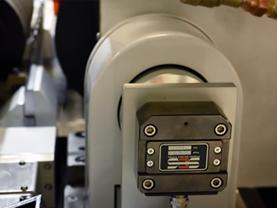
Wheel balancing is crucial to achieving a good surface finish in the workpiece and is critical to the spindle bearing life.
The Automatic Work Wheel Balancing System from Glebar Company dynamically balances the spindle through controls in the HMI. The automated system is more precise, ensuring the machine repeatedly produces a high-quality surface finish. As a result, the balanced wheel lasts longer and doesn’t need to be dressed as frequently increasing productivity.
“Using the Automated Balancing System helps reduce the time spent balancing the work wheel by as much as 90%,” said Mark Scanel, VP and General Manager of Glebar Customer Care.
Real-time balance conditions are indicated on the HMI allowing technicians to predict when the wheel needs to be rebalanced before the surface finish degrades. With the Automatic Balancing System, the operator can balance the wheel successfully in as little as 5 minutes, regardless of skill level.
The Glebar Customer Care team works with customers to minimize downtime and maximize the capabilities of their machines to increase production efficiencies.
The automatic wheel balancing system is available on Glebar’s TF-9DHD Infeed/Thrufeed Micro Grinder, GT-9AC Guidewire Grinding Machine, and GT-610 Automated Infeed/Thrufeed Centerless Grinder.
Contact Details
Related Glossary Terms
- grinding
grinding
Machining operation in which material is removed from the workpiece by a powered abrasive wheel, stone, belt, paste, sheet, compound, slurry, etc. Takes various forms: surface grinding (creates flat and/or squared surfaces); cylindrical grinding (for external cylindrical and tapered shapes, fillets, undercuts, etc.); centerless grinding; chamfering; thread and form grinding; tool and cutter grinding; offhand grinding; lapping and polishing (grinding with extremely fine grits to create ultrasmooth surfaces); honing; and disc grinding.
- grinding machine
grinding machine
Powers a grinding wheel or other abrasive tool for the purpose of removing metal and finishing workpieces to close tolerances. Provides smooth, square, parallel and accurate workpiece surfaces. When ultrasmooth surfaces and finishes on the order of microns are required, lapping and honing machines (precision grinders that run abrasives with extremely fine, uniform grits) are used. In its “finishing” role, the grinder is perhaps the most widely used machine tool. Various styles are available: bench and pedestal grinders for sharpening lathe bits and drills; surface grinders for producing square, parallel, smooth and accurate parts; cylindrical and centerless grinders; center-hole grinders; form grinders; facemill and endmill grinders; gear-cutting grinders; jig grinders; abrasive belt (backstand, swing-frame, belt-roll) grinders; tool and cutter grinders for sharpening and resharpening cutting tools; carbide grinders; hand-held die grinders; and abrasive cutoff saws.

